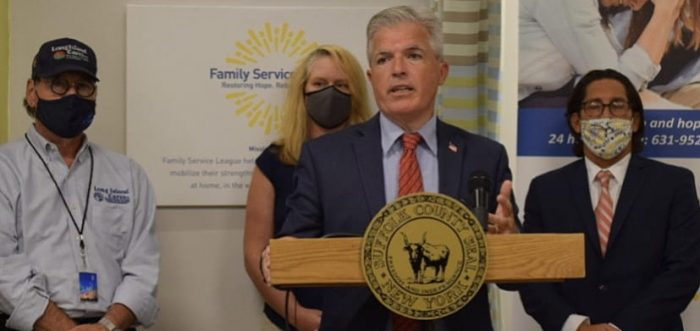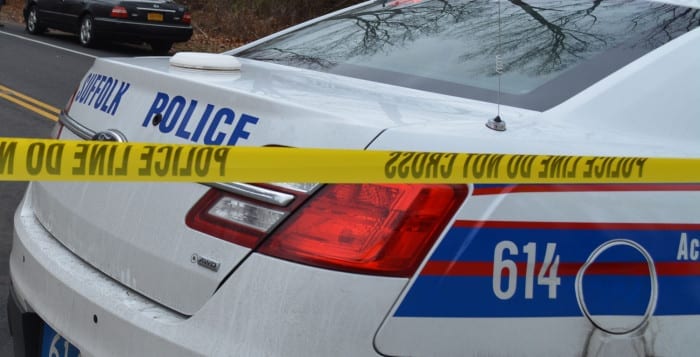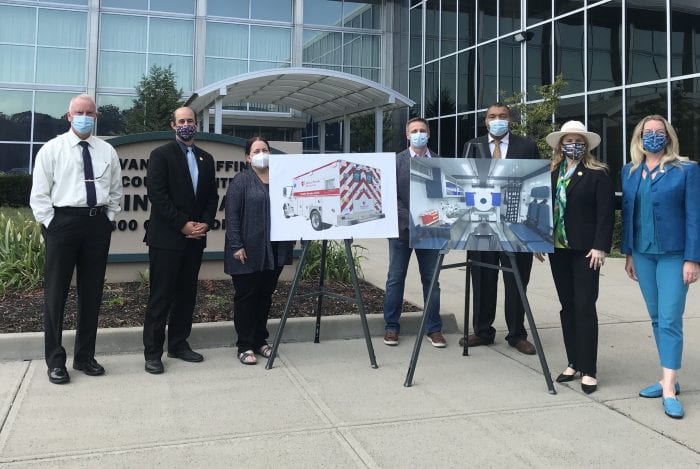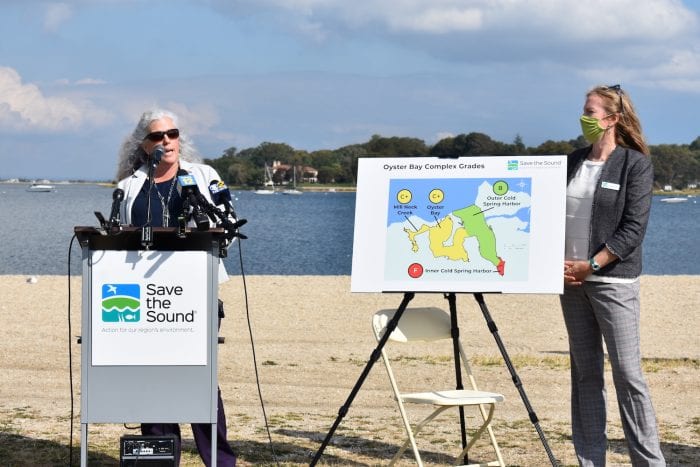At St. Louis de Montfort R.C. Church in Sound Beach, Monday, Oct. 19, those who came to mourn the passing of Chris Pendergast filled the pews, or at least as much as they could while trying to distance due to COVID-19.
Founder of ALS Ride for Life and renowned North Shore figure, Pendergast passed Oct. 14 surrounded by friends and family. He was 71. The nonprofit he founded reported Monday, Oct. 12, that Pendergast was starting to receive home hospice care. The organization announced his death Wednesday afternoon.

ALS Ride for Life started when Pendergast embarked on a ride with his electric scooter from Yankee Stadium in the Bronx to Washington, D.C., 22 years ago to raise awareness about the disease and raise funds for research. After a few years, the ride was contained to New York state — from Riverhead to the Bronx — where participants stop by schools along the way that take part in the organization’s presentations throughout the school year.
Pendergast, a Miller Place resident and former Northport elementary teacher had lived with amyotrophic lateral sclerosis, also known as Lou Gehrig’s disease, for 28 years. When doctors diagnosed him, they thought he only had a few years to live.
Many who gathered together to pay respects to the Ride for Life founder have been touched in some way by amyotrophic lateral sclerosis, also known as Lou Gehrig’s disease, a debilitating condition that, over time, paralyzes a person and eventually leads to their death. Father Francis Pizzarelli, director of nonprofit Hope House Ministries, led the funeral Mass at the church, and said to those gathered that his own brother had been diagnosed with the disease at 36 years of age several years ago. Without even knowing it at the time, the Pendergast family reached out to his brother to offer him advice and comfort, something that made “a profound difference in his life.”
Not only did he defy those odds, but he would spend more than two decades after his diagnosis raising millions for ALS research and spreading awareness for it.
Chris’ wife of close to 50 years, Christine Pendergast, said beyond all the work he’s done over the past two decades in advocacy and fundraising, he will be remembered by her and her family as a loving father.
“While everybody is remembering Chris as an ALS advocate and fighter, at the end of the day he was my husband, our children’s father and our grandson’s poppy,” she said.
Monday’s funeral Mass was one of somber remembrances, and tissue boxes were always close at hand. But at the same time, both Pizzarelli and the Pendergast family looked for ways to say though he may be gone, his life should serve as an example.
Pendergast’s daughter, Melissa Scriven, said during the funeral Mass her father was a supremely intelligent man, one who was exacting when it came to her homework as a child. Before he was diagnosed with the paralyzing disease, Pendergast was a handyman, able to “fix anything, even if it was with duct tape.” Her dad’s favorite meal to make when his wife was working late was “tuna noodle casserole, warm, with crushed Doritos … so my brother and I didn’t really like it when my mom worked late.”
During a funeral that was filled with music, some of which were songs Pendergast loved in life, Scriven played one she said was her dad’s favorite, John Denver’s “Take Me Home, Country Roads,” in which everyone’s tears dried ever so briefly as they joined in the chorus: “Country roads, take me home to the place I belong.”
Pendergast Leaves Lasting Mark
The founder of ALS Ride for Life became an icon and symbol for the North Shore for never giving up. Even as he lost the ability to speak and had to communicate with an eye-to-speech device, his determination never seemed to relent. Just this year, Pendergast, alongside his wife Christine, released the book “Blink Spoken Here: Tales from a Journey to Within” about his life since his diagnosis in 1993.
Ray Manzoni, chairman of the board for ALS Ride for Life based in Stony Brook University, knew Chris for many years, as both their kids went to school together in Miller Place. It was one day after both he and Pendergast were together after Mass that the educator told Manzoni he was likely to die in a few years, and that he wanted to raise awareness.

Since then, the organization has raised over $10 million for advocacy and research. Their yearly Ride for Life trips were later accompanied by visits to close to 90 school districts on Long Island.
“Anyone who knew him, I believe he helped us all to live a better life,” Manzoni said. “He was a teacher of gifted and talented kids, and he took this terrible disease and turned it into amazing positive life.”
Paul Weisman, a member of ALS Ride for Life, was diagnosed with the disease in January 2013. Getting introduced to Ride for Life, he started going out with the nonprofit’s founder during their school trips. He would also visit some districts without Pendergast. The organization and its founder gave him a real purpose, “something to strive for, something bigger than myself, to raise as much awareness to fight this disease.”
“Meeting Chris, he gave me hope that three to five years might not be true, that there may still be life here,” Weisman said.
Pendergast had four mantras: Never give up, never lose hope, always remain optimistic and be willing to defy the odds. Weisman loved that last one so much he had it tattooed on his left arm. Upon showing his new ink to the Ride for Life founder, Weisman said his mentor and friend smiled.
“Chris could smile and light up a room,” he said. “We all want to do something with our lives, but he certainly did.”
Pendergast’s roots on the North Shore ran deep, so much so that he became renowned in local school districts. He traveled from classroom to classroom, auditorium to auditorium, helping young people from elementary on up understand ALS but, more importantly, serve as a role model for what bravery truly looked like. Manzoni said students would often embrace Pendergast after these talks. As the years fell by, young students who were inspired by the Ride for Life founder would internalize his message. The board chairman said one time an EMT stopped by the side of the road during the annual ride and told Pendergast how his example inspired them to want to help others.
“If you had the honor of meeting him, riding or walking next to Chris in his ALS Ride for Life from Montauk to Manhattan, or hearing his story of determination, you walked away a better person,” Miller Place Superintendent of Schools Marianne Cartisano wrote in a statement. “He left you with the lasting impressions that made you want to be more tolerant, kinder, more understanding and compassionate toward others. His fight against the devastation of ALS left you inspired, knowing him filled your heart and being in his presence left you humbled.”
ALS Ride For Life Talks Future Efforts
Despite the passing of its founder and leader Chris Pendergast, ALS Ride for Life isn’t thinking of slowing down anytime soon.
Manzoni said the organization wants to continue its fundraising efforts, starting with himself getting on a bike later this month and hitting the road, going to school districts they have visited before the pandemic. He plans to spend enough time at each to wave to children and “hopefully greet someone who has supported our program and to say ‘thank you’ to them, give them banner in recognition.” The organization has also developed a revised packet on how, even during a pandemic, people can support ALS over the school year.
“ALS is not going away, and we have to continue the fight,” he said.
There are even talks of doing a documentary film on Pendergast’s life, something Manzoni said the organization is wholeheartedly all for.
Weisman, still an active member of Ride for Life, said one of his last conversations he had with Pendergast was “to keep going until we found that cure for ALS,” he said. “He firmly believed, as I do, that there’s a major breakthrough coming somewhere around the corner … it’s up to us to finish it.”
Weisman added that while the pandemic has made their normal school trips much more difficult, they have some preliminary ideas to host online talks instead.
“Chris laid down 28 years of work,” he said. “Now it’s up to us.”
The family requests donations be made to ALSrideforlife.org and Hope House Ministries at HHM.org.



















